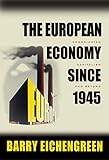The European economy since 1945 : coordinated capitalism and beyond /
By: Eichengreen, Barry J
Material type: BookPublisher: Princeton : Princeton University Press, c2007.Description: xx, 495 p. : ill ; 24 cm.ISBN: 9780691138480Other title: The European economy since ninety forty five.Subject(s): Europe -- Economic conditions -- 1945-DDC classification: 330.94 EI EU Online resources: Location Map
BookPublisher: Princeton : Princeton University Press, c2007.Description: xx, 495 p. : ill ; 24 cm.ISBN: 9780691138480Other title: The European economy since ninety forty five.Subject(s): Europe -- Economic conditions -- 1945-DDC classification: 330.94 EI EU Online resources: Location Map | Item type | Home library | Call number | Status | Date due | Barcode | Item holds |
|---|---|---|---|---|---|---|
| REGULAR | University of Wollongong in Dubai Main Collection | 330.94 EI EU (Browse shelf) | Available | T0040820 |
, Shelving location: Main Collection Close shelf browser

|

|

|

|

|

|

|
||
| 330.91823 JO CO Coming full circle : | 330.94 AU EU Europe's financial crisis : | 330.94 BE YO Beyond varieties of capitalism : | 330.94 EI EU The European economy since 1945 : | 330.941 CR IS Crisis and recovery : | 330.94107 MO BI The birth of industrial Britain : | 330.9410857 CH CO Controversies in macroeconomics / |
Includes bibliographical references (p. 433-459) and index.
Chapter 1. IntroductionChapter 2. Mainsprings of GrowthChapter 3. The Starting PointChapter 4. Dawn of the Golden AgeChapter 5. Eastern Europe and the Planned EconomyChapter 6. The Integration of Western EuropeChapter 7. The Apex of the Golden AgeChapter 8. Mounting Payments ProblemsChapter 9. Declining Growth, Rising RigiditiesChapter 10. The Collapse of Central PlanningChapter 11. Integration and AdjustmentChapter 12. Europe at the Turn of the CenturyChapter 13. The Future of the European ModelAppendix. Sources of Growth.
In 1945, many Europeans still heated with coal, cooled their food with ice, and lacked indoor plumbing. Today, things could hardly be more different. Over the second half of the twentieth century, the average European's buying power tripled, while working hours fell by a third. The European Economy since 1945 is a broad, accessible, forthright account of the extraordinary development of Europe's economy since the end of World War II. Barry Eichengreen argues that the continent's history has been critical to its economic performance, and that it will continue to be so going forward. Challenging standard views that basic economic forces were behind postwar Europe's success, Eichengreen shows how Western Europe in particular inherited a set of institutions singularly well suited to the economic circumstances that reigned for almost three decades. Economic growth was facilitated by solidarity-centered trade unions, cohesive employers' associations, and growth-minded governments--all legacies of Europe's earlier history. For example, these institutions worked together to mobilize savings, finance investment, and stabilize wages. However, this inheritance of economic and social institutions that was the solution until around 1973--when Europe had to switch from growth based on brute-force investment and the acquisition of known technologies to growth based on increased efficiency and innovation--then became the problem. Thus, the key questions for the future are whether Europe and its constituent nations can now adapt their institutions to the needs of a globalized knowledge economy, and whether in doing so, the continent's distinctive history will be an obstacle or an asset.
